Given their recent transfer ban, nobody expected much of Chelsea this season. But with Frank Lampard’s team showing extreme progression, they are firmly in the hunt for a Champions League place. Through his ability to find the right balance between experience and youth, Chelsea have been a joy to watch this season. With signs of brilliance this season even with a squad that Lampard inherited, next season holds plenty of promise.
Chelsea have begun their 2020/21 recruitment very early. Announcing the signing of Hakim Ziyech a few months ago, and recently the significant capture of Timo Werner from RB Leipzig. The blues are also in the hunt for a new left-back to replace Marcos Alonso. With all these signings, their team is shaping up nicely for next season, apart from one position. Goalkeeper.
Kepa Arrizabalaga’s struggles have been well documented since joining and was replaced by 38-year-old Willy Caballero before the restart. Although he has now regained his place, there are rumours that Lampard would be open to the prospect of a new number one.
Through data analysis, we will aim to identify the best possible replacements for Kepa. We will compare his and Chelsea’s passing style to Europe’s best keepers to find a replacement that could easily fit into their tactics. We will then create a shortlist of similar players, and identify which keepers have had the best season. Then we will select a goalkeeper for three different scenarios – a sensible option, a risky option, and a temporary option. The latter would be useful if Chelsea looks to loan Kepa out to gain experience.
Filters
We set criteria to find the right type of replacement for Kepa, although some may not be realistic, we got rid of these later in the process. The most important criteria were keepers that are of a high standard, and have the experience to match. Therefore, our data only contained goalkeepers from Europe’s top five leagues, the Eredivisie, and Portugal’s top league. Although the latter two aren’t of the highest quality, we only considered players who have the experience in the Europa League and Champions League.
We wanted a goalkeeper that could stay at Chelsea for a while, so we considered age. Given that goalkeepers can play well into their 30s, we filtered goalkeepers under the age of 31. This gave us a good range of keepers that would fit into different transfer scenarios.
Chelsea have already made two big-money signings in Werner and Ziyech, so it would be sensible to put a cap on the transfer fee. We set the maximum cost to under €40milion.
To get a good idea of the current form that players are in, we only analysed goalkeeper’s that have played over 1,600 minutes of football this season.
Using these filters we got an initial sample of 64 goalkeepers. Still fairly big, we then created graphs to analyse which ones best matched up to Kepa and Chelsea’s playing style. Then we looked at which keepers were better than Kepa in a sweeping role.
Why would Chelsea want to replace Kepa?
The Spaniard has great reflexes which makes him a very good shot-stopper, he also has very good passing technique which means that he is adept at playing out from the back. However, his decision-making skills are what lets him down. He often tries to pass short to teammates when they are under pressure and finds it difficult choosing which save technique to use which often leads to mistakes. His small build also means he can’t dominate his box as well as other goalkeepers.
Here is how Kepa compares to the initial sample in terms of shot-stopping.
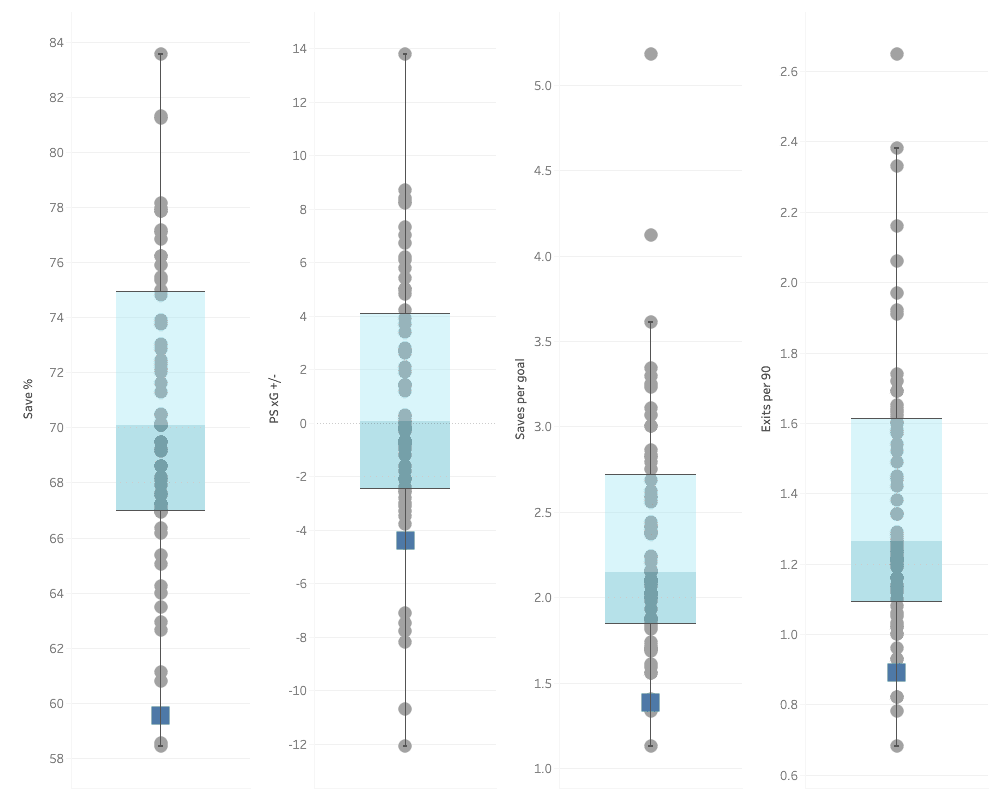
The graph does not flatter Kepa at all. For save %, post-shot xG +/-, saves per goal, and exits per 90 he is in the lower quartile. This emphasises how much Kepa has underperformed when being compared to similar goalkeepers, let alone the best goalkeepers in Europe.
Metrics
We will create a shortlist of the players that show up most often in the following graphs. This will allow us to find the keepers most similar to the current Chelsea keeper. Keepers who are similar in one field are red in colour, while those who are similar in both fields are orange.
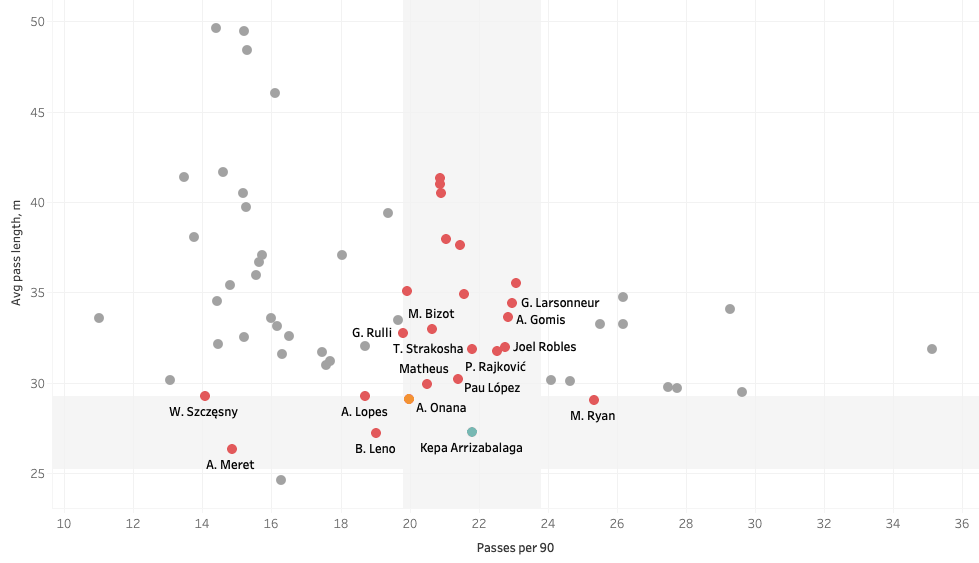
Kepa makes 21.81 passes per 90, with an average length of 27.25 metres. Players similar would have made between 19.81 and 23.81 passes per 90, with an average length of between 25.25 and 29.25.
André Onana of Ajax is the only keeper that is similar in both fields. He makes 19.97 passes per 90 with an average length of 29.10 metres. The Cameroonian has been previously linked with Chelsea after his impressive displays in the Champions League and numerous league titles with his club.
Premier League duo Mat Ryan and Bernd Leno are very close to Kepa too. Ryan making more passes than both with 25.34 per 90. Leno and Kepa’s passing distance is very similar, Leno averaging 27.20 metres.
The other two players that stand out are Braga number one Matheus, and former Tottenham loanee Pau López. Matheus makes 20.49 passes per 90 with an average distance of 29.93 metres, whilst López makes 21.40 passes per 90 with a similar average distance.
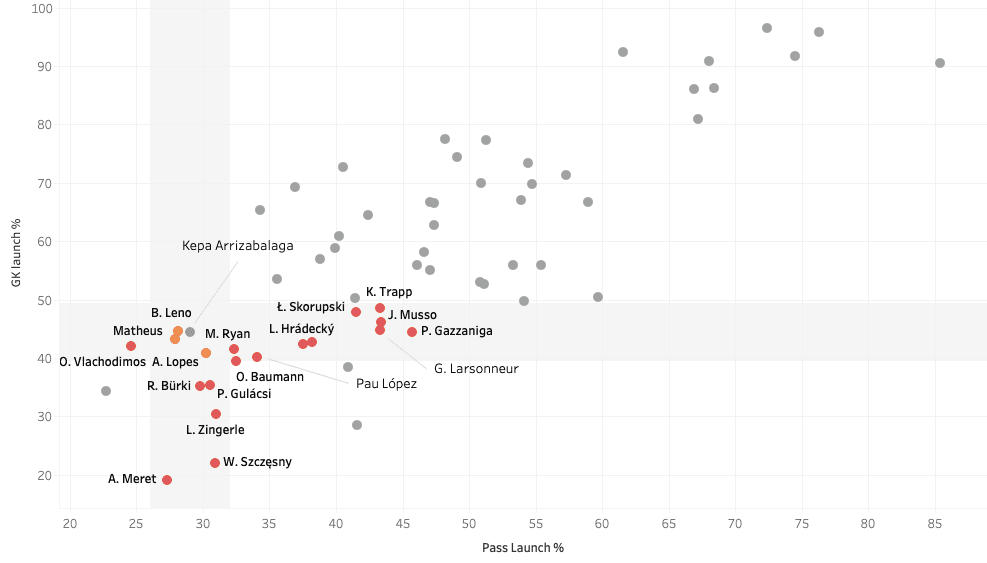
The Chelsea man launches 44.40% of his goal kicks and only 29% of his in-play passes – clearly favouring a passing style of play. Similar players marked launch between 39.40 and 49.40% of their goal kicks, and between 26 and 32% of their passes.
Three goalkeepers stand out in this graph, two of whom we have mentioned previously. Matheus launches 43.30% of his goal kick and 27.90% of his passes. Arsenal’s Leno launches 44.60% of his goal kicks and only 28.10% of passes. Both have very similar statistics to Kepa. The third is Lyon stalwart, Anthony Lopes. The 29-year-old is close to Kepa in both stats, he launches 40.90% of his goal kicks and 30.20% of his passes.
Borussia Dortmund’s Roman Bürki shows similar tendencies too, with 35.20% goal kick launch and 29.80% pass launch. Ryan and Pau López have similar stats here again.
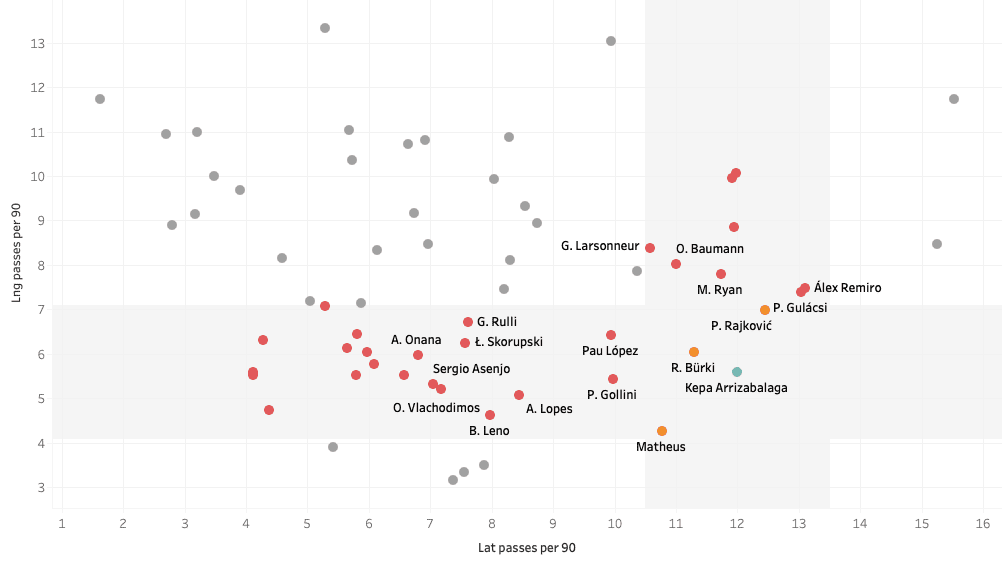
The above graph analyses the type of passes played. Kepa plays 12 lateral passes per 90 and 5.59 long passes per 90. Similar players marked are 1.5 metrics above/below Kepa’s stats.
Matheus, Bürki, and, Predrag Rajković of Stade de Reims are most like Kepa in these stats. Matheus has 10.77 lateral passes and 4.26 long passes per 90. Bürki is most like Kepa with 11.29 lateral passes and 6.03 long passes per 90. Serbia keeper Rajković has enjoyed a breakthrough season with his club, his playstyle being central to this. He has 12.45 lateral passes and 6.98 long passes per 90.
Ryan again shows up close to Kepa, with similar lateral passes, but the Spaniard having fewer long passes. Pau López is also close again, with Onana, Lopes, and Leno similar in long passes, but less lateral passes.
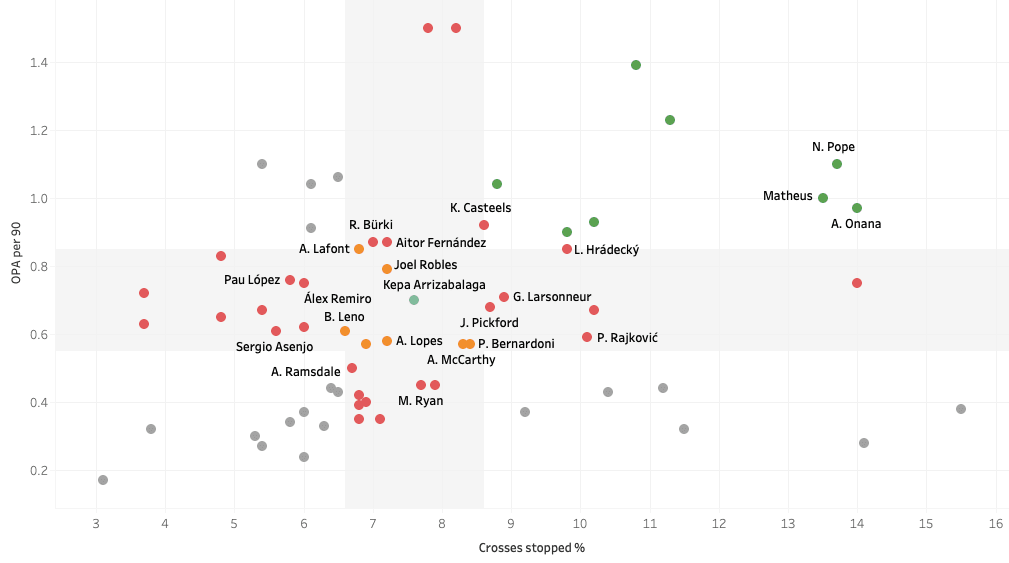
Out of keepers that we have already mentioned, Lopes and Leno have the same ‘sweeper’ tendencies as the Spaniard. Leno has 0.61 OPAs per 90, and has stopped 6.6% of crosses into his box. Lopes has stopped 7.2% crosses and has 0.58 OPAs per 90.
However, Onana and Matheus are far better than Kepa in these statistics. Both are more adept at helping out their defence. Onana has 0.97 OPAs per 90 and has stopped a huge 14% of crosses he has faced whilst Matheus stops 13.50% and averages 1 OPA per 90.
So which keepers are most similar to Kepa?
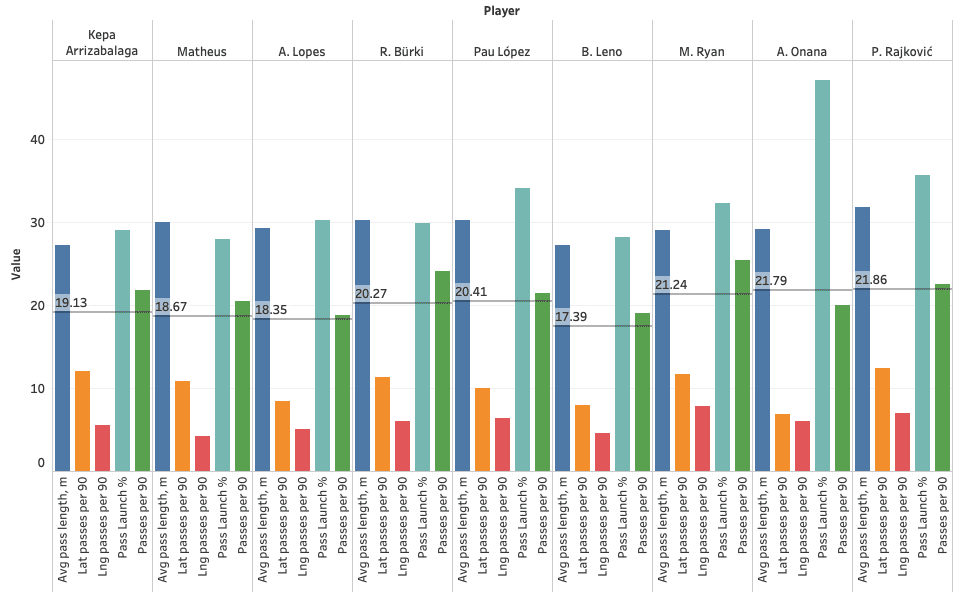
The above graph shows the goalkeeper’s that are most similar to the current Chelsea keeper. We can see which aspects they are similar in, as well as their overall average pass rating that can be compared to Kepa. Matheus is most similar, followed by Lopes and then Bürki. However, given how similar they all are, any one of these would be a good tactical fit for Chelsea.
So we have now shortened the shortlist to just eight players, let’s see how they compare in shot-stopping terms.
The standout performers
With all goalkeepers following the set filters and having similarities to Kepa and Chelsea’s playing style, we must now assess which are the stand-out performers. This will help us shorten the shortlist even more, to three players; the best option, a risky option that would cost less, and a temporary option.
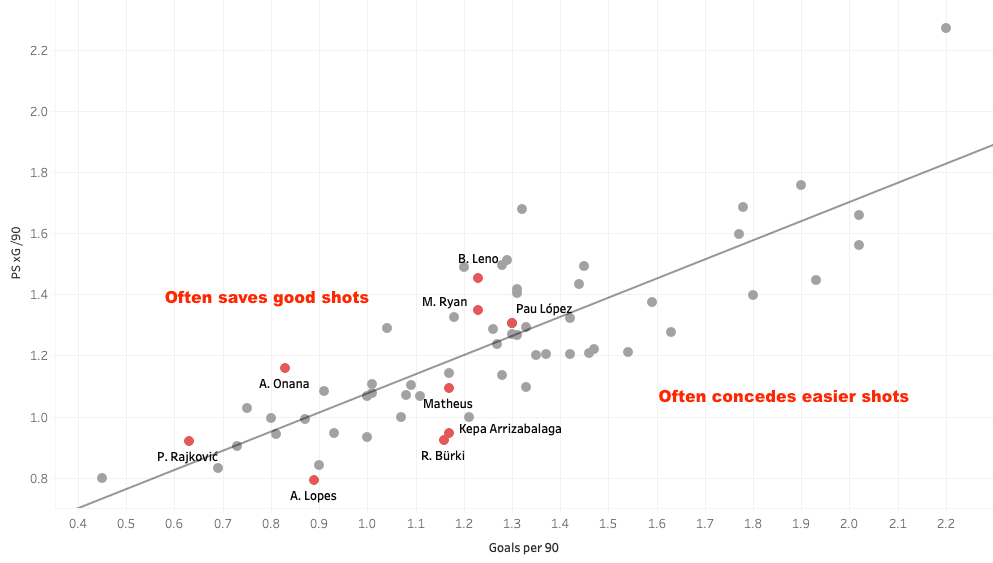
The above graph shows how the keepers perform against their expected performance. The players towards the bottom left of the map don’t concede many goals and aren’t expected to either. Onana and Lopes’ clubs rank amongst the best in their respective leagues, therefore they have a good defence in front of them, meaning these stats are often harsher on the more well-known keepers. But Onana is the better performer, with 1.16 PS xG per 90 and only 0.83 goals conceded per 90. Though Lopes is further down, he is still performing close to how he was expected, with 0.79 PS xG per 90 and 0.89 goals conceded per 90.
Rajkovic’s club wasn’t expected to have a good season, this is why his stats are so good here. With the support of a surprisingly strong defence, the Serbian was expected to concede 0.92 goals per 90 but only concedes 0.63.
Kepa, Matheus, and, Bürki disappoint the most, all conceding more than they were expected to.
But on the other hand, Leno, Ryan, and, Pau López all show very impressive stats. The Arsenal shot-stopper was expected to concede 1.45 goals per 90, but only concedes 1.23 – very impressive considering his teams’ defensive woes this season. The experienced Ryan also having an impressive season, with 1.35 PS xG per 90 and only 1.23 goals per 90 – very good for a team fighting relegation.
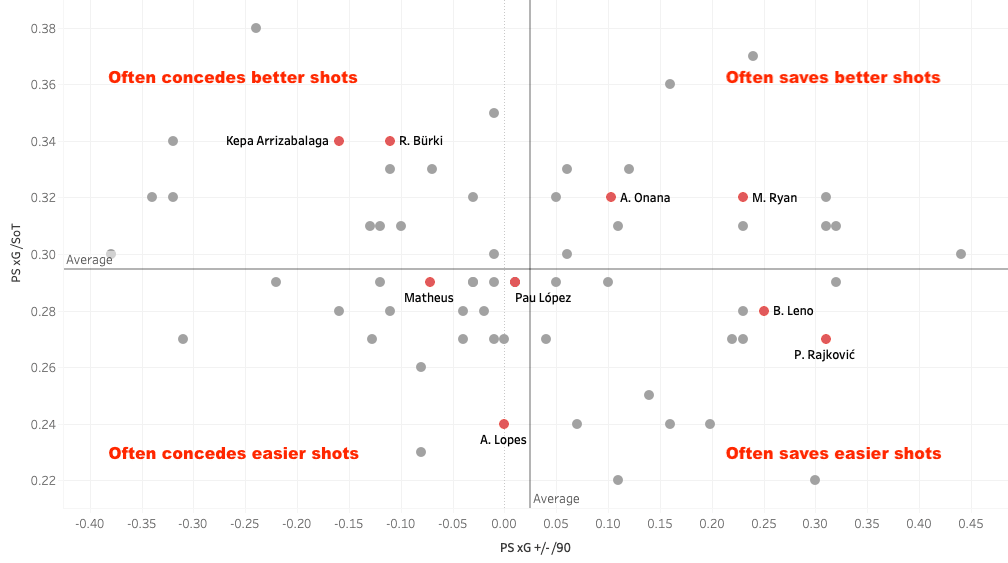
This graph tells us how often the sample saves shots, and how difficult these shots are.
Obviously here, Onana and Ryan are the most impressive. Both keepers have performed excellently this season, facing difficult shots, compared to other keepers. Both face a PS xG per shot on target of 0.32, considerably above the average. Onana saves 0.10 more goals than he should per 90. Although impressive, Ryan saves more with 0.23.
Leno, Pau López, and, Rajković also save more goals than they were expected to but face easier shots than the previous two keepers. Rajković impresses the most, facing a PS xG per shot on target of 0.27, but saving 0.31 more goals per 90 than he was expected.
Lopes has achieved what he was expected to this season. Although he faces easier shots, mainly due to his strong defence, he saves the majority of them. He faces a PS xG per shot on target of 0.24 and has a PS xG +/- per 90 of 0.
Kepa, Bürki, and, Matheus have conceded more goals than they were expected to this season. The Chelsea and Dortmund keepers have faced more difficult shots than Matheus with a PS xG per shot on target of 0.34. Whilst the Benfica shot-stopper faces a PS xG per shot on target of 0.29 but conceding 0.07 more goals than he was expected to per 90.
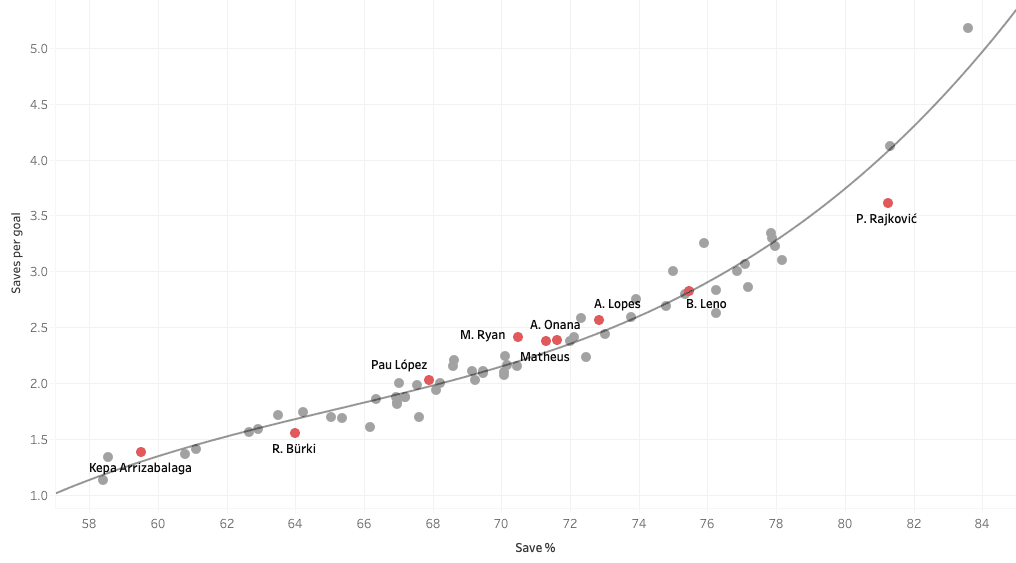
This graph evaluates one of the most common statistics within a goalkeepers analysis, save percentage. Save percentage measures how often a goalkeepers save shots that they face, whilst saves per goal tell us how many saves a keeper makes before they concede.
Rajković impresses the most once again. The Serbian, on average, makes 3.61 saves before he concedes, saving 81.25% of shots in the process. Second-best is Leno, with a save percentage of 75.47% and making 2.82 saves before he concedes.
Lopes and Onana follow closely behind, with a save percentage of 72.83% and 71.62% respectively. The Ajax keeper makes 2.38 saves before conceding whilst Lopes makes slightly more with 2.56.
Three-man shortlist
After analysing every goalkeeper’s shot-stopping ability and performances this season, we are now able to shorten the shortlist further to find an obvious option, risky option, and temporary option.
We must begin by eliminating unrealistic candidates from the current shortlist. Leno is unlikely to be sold to Chelsea, as they are direct rivals to Arsenal. And Pau López is unlikely to join as he had recently joined Roma.
Bürki and Matheus have both had disappointing seasons compared to the rest of the shortlist, they have both conceded more goals than they were expected to. Matheus conceding 1.79 more goals and Bürki conceding 3.3 more goals than expected.
Onana, Rajković and Ryan are the most obvious option after taking their goalkeeping stats into consideration. This leaves Lopes, missing out simply because the other three have performed much better this season.
Conclusion
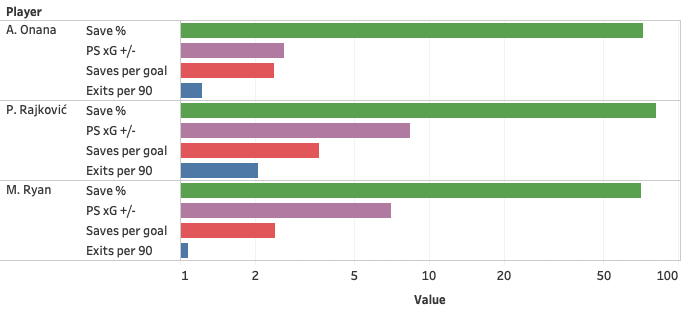
The temporary replacement – Lampard may be looking to loan Kepa out to gain experience in different scenarios, maybe in a team with a weaker defence to test him more. We have seen Caballero take over from Kepa at certain stages of the season, but with the former leaving at the end of the season Chelsea could look to bring in another keeper anyway. Out of the three, Mat Ryan would be the most sensible pick here.
The 28-year-old is experienced in the Premier League after playing over 100 games for Brighton. Ryan would fit perfectly into Chelsea’s style of play, and after hitting some form this season, and being valued at €8million, could be a safe option for the blues.
The risky option – Kepa is now 25-years-old, so his bad form can’t be put down to inexperience. If the Spaniard is to be sold, it would be sensible for Chelsea to find a long-term replacement. Predrag Rajković of Reims could be a great option here. The Serb has been one of the best goalkeepers this season and, like his club, has exceeded expectations.
However, having only joined Reims in July 2019 from Maccabi Tel Aviv, it could be seen as a rather risky option. This season has been by far his best, this could be his only above-average season. And with limited experience in a top league could be a problem for Chelsea.
The obvious and best option – If Chelsea are ultimately looking for a goalie to directly replace Kepa and make an instant impact, André Onana is the obvious choice. The 24-year-old has been one of the best young keepers in the world for the past few seasons. The Cameroonian has impressed in the Champions League and Eredivisie.
Onana has shown a great range of passing for Ajax. He is as comfortable playing short to his defenders as he is launching an accurate pass to his wingers. His incredible reflexes and reach allow him to stop all types of shots, whilst his big build helps him stop one-on-one situations.

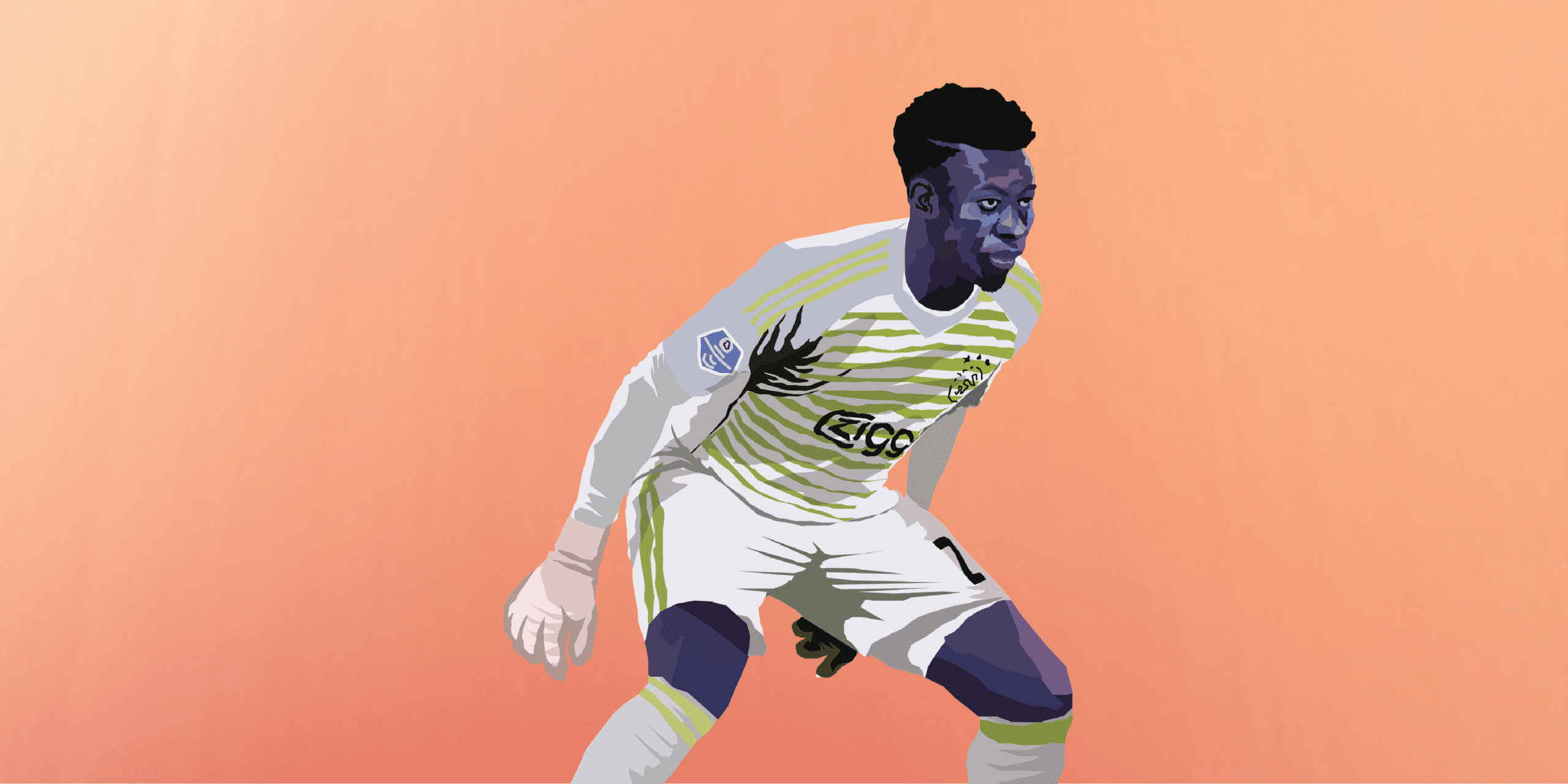



Comments